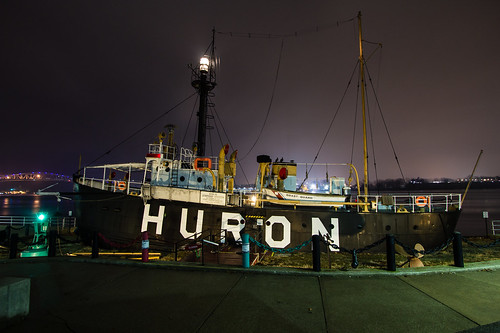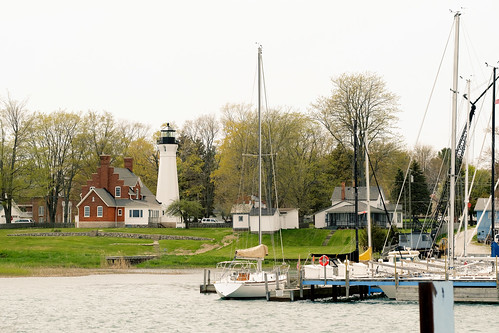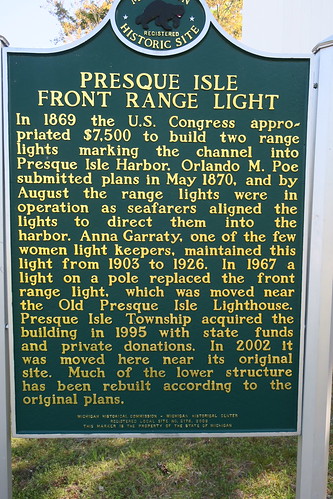Lighthouses of Michigan’s Sunrise Coast
Author's note: To receive a free PDF of Exploring Michigan’s Upper Peninsula Coasts, visit https://jkroyce.wordpress.com/ and request via email on the top right sidebar. Offer available 5/26/22-6/8/22
The traveler to Michigan’s coastlines will be rewarded with the opportunity to visit many iconic lighthouses. As I traveled, writing and compiling information for my three-volume travel series, Exploring Michigan's Sunset Coasts, Sunrise Coasts, and Upper Peninsula Coasts, they added a bit of delight and historic perspective to the trip. Below are some of my favorites.
In his book America’s Lighthouses: An Illustrated History, Francis Ross Holland Jr. wrote, “They are called lakes, but from the lighthouse point of view they have virtually all the characteristics of the ocean.”

Huron Lightship Museum
Located at 800 Prospect Place, docked in Pine Grove Park, Port Huron
The Huron Lightship was commissioned in 1921 as Lightship Number 103. She operated in southern Lake Huron at the mouth of the St. Clair River. A lightship is a floating lighthouse that is placed at a site where a regular lighthouse isn’t feasible. Sometimes a lightship is used while the permanent lighthouse is being constructed. The Huron was the third lightship placed at the Corsica Shoals where a shallow ridge of sand had grounded many ships. The light is fully automated and managed by the U.S. Coast Guard.
When retired from active service in 1970, the Huron Lightship was the last lightship on the Great Lakes. The ship is well-preserved, with her operable light and fog horn still on board. If you are a maritime history buff, you’ll find this museum packs fascinating history on a short tour. Call to make sure the museum is open.

Fort Gratiot Lighthouse
Located at 2800 Omar Street in Port Huron, just north of the Blue Water Bridge
The Fort Gratiot Lighthouse is the oldest operating lighthouse on the Great Lakes. It was built in 1825. The tower is 86 feet above the lake level. The keeper’s cottage and the fog whistle house are painted red. The lighthouse is red brick painted white. It is a classic example of an early nineteenth century style lighthouse. The tower collapsed in 1828 due to shoddy workmanship. It was rebuilt in 1829. Additional rebuilding was required in 1861.
It is worth the climb to the top for the view. It is one of the few operating lighthouses that allow visitors to climb the tower. However, the climb to the tower is only available as part of the tour. From that perch you can see where the St. Clair River runs into Lake Huron. You can also see the Blue Water Bridge and Canada on the other side.

Port Sanilac Lighthouse
Located two blocks east of the Municipal Harbor on Lake Street
Between the Fort Gratiot Lighthouse and the Pointe aux Barques Lighthouse stretched 75 miles of dark of Lake Huron shoreline. The dangerous, unlit portion of Lake Huron was made safer when Harbor Beach got a lighthouse in 1875 and Port Sanilac’s light began operating 11 years later.
The Port Sanilac Lighthouse is 59 feet tall and is connected to a two-story, eight room keeper’s dwelling by a covered passageway. The first keeper was Richard Morris, who had been promoted to Port Sanilac from his position as assistant keeper at Thunder Bay Island Lighthouse. Morris suffered some weather-related difficulty getting to his new assignment, but on October 20, 1886, he sent the first beams out over Lake Huron.
This lighthouse is currently a private residence and not open to the public, but you can see it from the street or the parking lot that runs along its south side. It is worth a drive down Lake Street in Port Sanilac to glimpse this architecturally relevant lighthouse.

Charity Island Lighthouse
Located via a short boat cruise from Caseville to Big Charity Island
The largest island in the Saginaw Bay, Charity may be the dream escape of your summer with its 11-acre, spring-fed pond—a mini-lake within the greater lake. The lighthouse was built to help ships avoid dangerous shoals extending from the northern and southern shores of the island.
The island is 322-acres of stone and mixed hardwood forest. It is home to rare and protected species of plants including trillium, Jack in the pulpit, pink lady slippers, and pitcher’s thistle. You may see a bald eagle as you walk the beach. The island was given its name by the lake mariners who believed it was “only by the charity of God” they made it through the dangerous channel midway between the city of Au Gres and the Thumb at the entrance to the Saginaw Bay.
The lighthouse first beamed onto Lake Huron waters on May 26, 1857, the date the lighthouse keeper arrived. The lighthouse is a 39-foot-tall brick tower located on a slight rise. It provided a 13-mile range of visibility. The Charity Island light was a difficult lighthouse to maintain because of its vulnerability to the elements. Of all of the lighthouses in the Thumb, it may have been in the worst condition when the Charity Island Preservation Committee began attempts to stabilize and preserve it. Tours of the island are available, you can camp on the island, and there are rentals available.
A note of interest: The lighthouse and the keeper’s house were built on different parcels of land. The house was owned by individuals who finally had it demolished because it attracted too many curious visitors and could not be restored to accommodate safety. The preservation attempts are only for the lighthouse.

Photo courtesy CharityIsland.net, used with permission
Tawas Point Lighthouse
Located at 686 Tawas Beach Road, East Tawas
The Tawas Point Lighthouse operated from 1876 to 2016, was electrified in 1935, and automated in 1953. The lighthouse was temporarily closed in 2021 due to COVID, although the Friends of the Tawas Point Lighthouse and State Park and volunteer lightkeepers offered some outdoor programming during the pandemic. If you want to see more than the outside of the lighthouse, check the web for current status and hours.

In normal times, the Michigan Department of Natural Resources managed the lighthouse and afforded visitors the opportunity to climb the 85 steps of the tower. Each room of the lighthouse museum was open and represented a different period from the life of the lighthouse.
Tours last approximately 45 minutes, and you can visit the Lighthouse Museum Store and the Lighthouse Memory Walkway after your tour.

Presque Isle Lighthouses and Park
The Old (1840) Presque Isle Lighthouse
Located at 5295 East Grand Lake Road
One of the oldest lighthouses on the Great Lakes, the 1840 Presque Isle Lighthouse is located on the Lake Huron shoreline near Presque Isle Harbor. The Old Light’s tower rises 30 feet tall. It is 18 feet in diameter at the base. The bottom conical two-thirds is stone. Above that is a brick section with a soapstone deck. You can visit the grounds, enjoy a picnic, or relax in the tranquil lakeside setting. The Old Light served from 1840-1870.
You can access it by parking at the Presque Isle State Harbor Marina and hiking less than a third of a mile down the trail from the breakwater.
The Presque Isle Light Station is at the north end of Presque Isle Peninsula, one mile beyond the Harbor and the Old Lighthouse. It is a 99-acre facility owned by Presque Isle Township and operated as a park and museum.
The New (1870) Lighthouse and The Range Light Park
Located at 4500 East Grand Lake Road
This lighthouse has a parking lot and is accessible by car. The new light has served from 1870 to the present and remains an active aid to navigation. The light is 113 feet tall, the tallest accessible lighthouse on the lakes. It’s diameter at the base is 19 feet 3 inches and 23 feet 4 inches at the parapet.
The structure was designed by Army Engineer Orlando M. Poe. It is one of nine Poe Lights that guard the Great Lakes and the only one on Lake Huron. The light is distinguished by four evenly spaced windows directly below the lantern room. Another signature trait is the wrought-iron bracket supporting the gallery. Its third Order Fresnel lens could be seen more than 25 miles out into Lake Huron. The restored lens is on display in the 1870 Keeper’s House.

The new light is open to the public and weather permitting, you can climb the tower. To do so you must be more than 42 inches tall, and children under 12 must be accompanied by an adult. Views from the tower are spectacular.

Trails near the New Lighthouse allow visitors to hike, birdwatch, and enjoy the wildflowers.

40-Mile Point Lighthouse
Located seven miles north of Rogers City
Lake Huron is arguably the most dangerous of the five great lakes for ships. Huron is also the connecting link between the other lakes. In the late 1800s, hidden shoals and false bays claimed many vessels and their crews in the waters between Mackinaw City and Alpena. It was a dark area, meaning no lighthouses steered ships clear of the hazards. Recognizing the problem, the Federal Lighthouse Board approved construction plans for a new lighthouse north of Rogers City. Work began in 1896, and the light first blazed its beacon into the inky nighttime waters in April 1897.
Every lighthouse has its story and its charm, but 40-Mile Point Lighthouse will likely become one of your favorites. It is more than a lighthouse. It is a lighthouse park and fascinating museum. It is open year-round for exterior viewing, but hopefully you’ll arrive when the buildings are open. The 52-step climb up the winding iron stairs is worth the effort for the bird’s-eye view of Huron’s majesty.

The Pilot House of the Calcite, one of the first self-unloading vessels to sail the lakes, resides on the grounds and is open for your scrutiny. A volunteer is available to provide a wealth of maritime history.
Visitors can walk the beach and examine the skeletal remains of the Joseph S. Fay. On October 19, 1905, the Fay was downbound towing the schooner barge D.P. Rhodes when a savage storm bore down on her. The Rhodes survived when she was blown free of the Fay. The Fay broke up on a sandbar near the 40-Mile Point Lighthouse. All but the First Mate made it ashore. A portion of the Fay’s starboard side lies on the beach just west of the lighthouse. She is held steady in the sand by her rods and spikes.
Group tours are available by appointment. The one downside to this lovely lighthouse and park is that you may have to carefully pick your way through poison ivy.

For more Sunrise Coast lighthouses, please read my guide, Exploring Michigan’s Sunrise Coasts.
Click through to read excerpts from Royce's three books exploring Michigan's coasts:
Julie Albrecht Royce, the Michigan Editor for Wandering Educators recently published a three-book travel series exploring Michigan’s coastlines. Nearly two decades ago, she published two traditional travel books, but found they were quickly outdated. This most recent project focuses on providing travelers with interesting background for the places they plan to visit. Royce has published two novels: Ardent Spirit, historical fiction inspired by the true story of Odawa-French Fur Trader, Magdelaine La Framboise, and PILZ, a legal thriller which drew on her experiences as a First Assistant Attorney General for the State of Michigan. She has written magazine and newspaper articles, and had several short stories included in anthologies.
-

- Log in to post comments




















